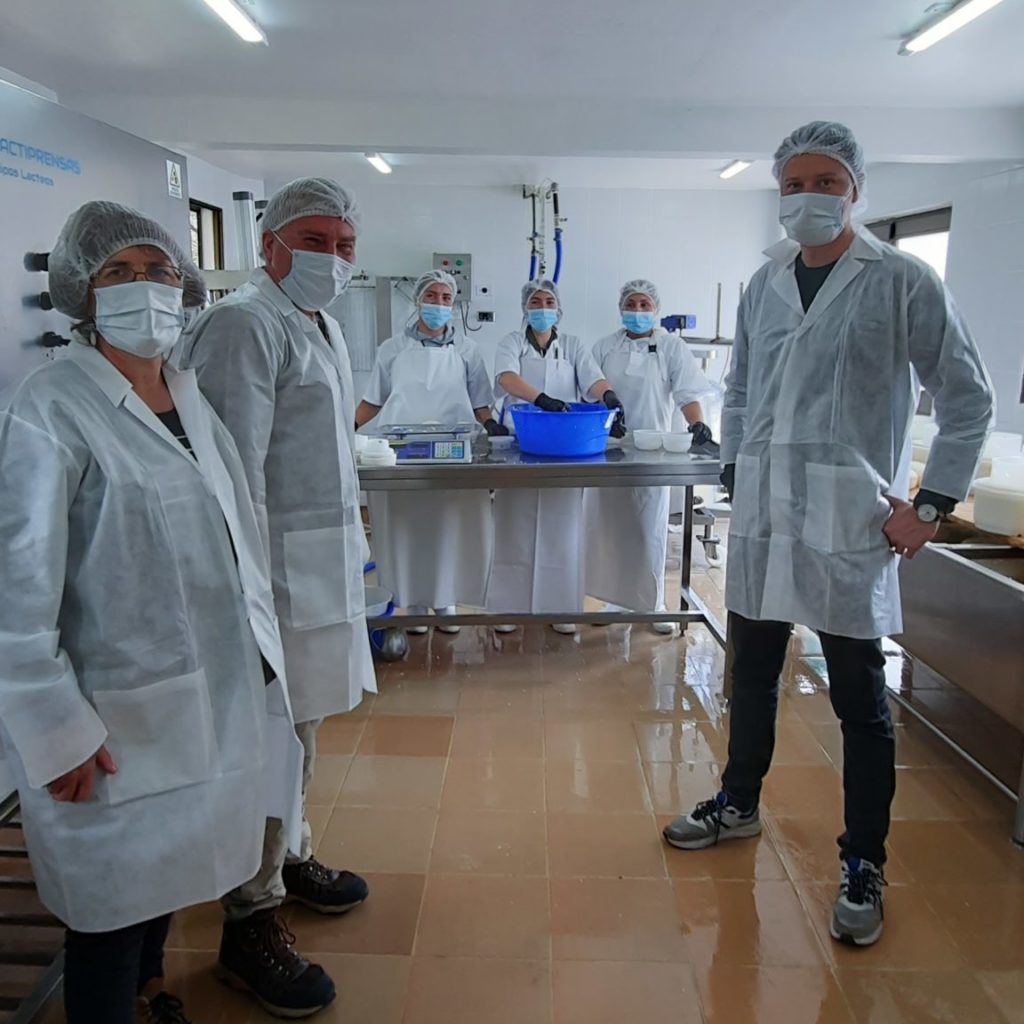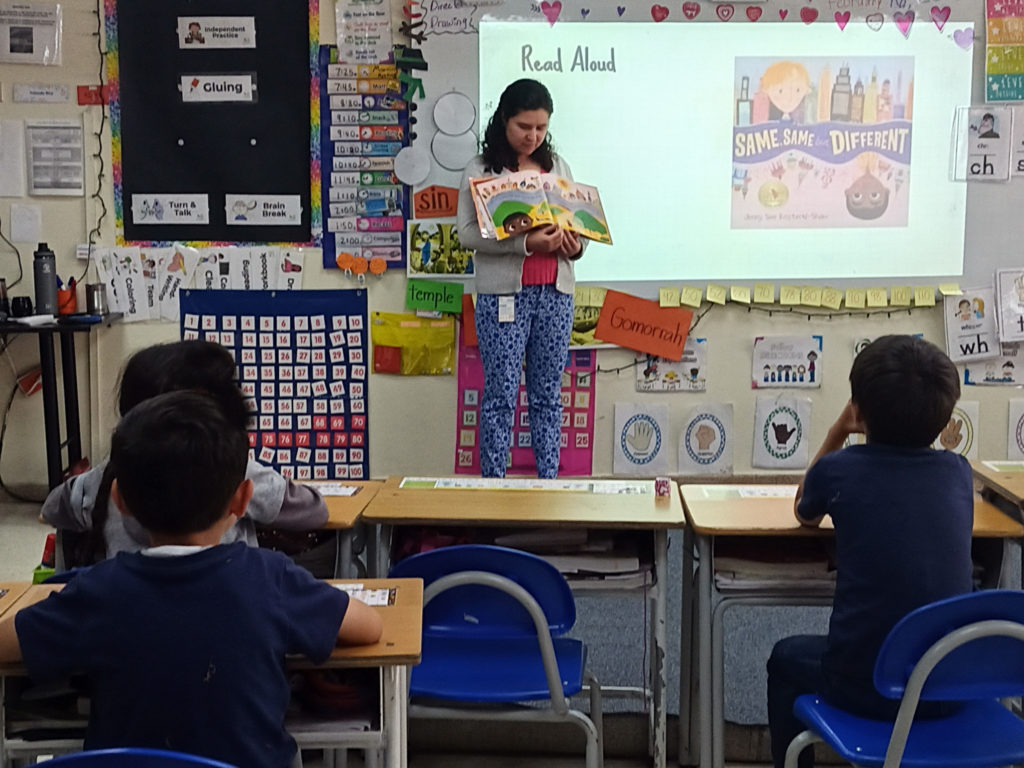Why fight with nature and the seasons? We plan our cow’s well-being around spring grass growth, longer days of summer sunshine, and slowing down over the cold winter. This means our cows get a rest from giving milk for four to six weeks before they have a baby in March or April. While the cows are on vacation from producing milk, the farmers get to take a vacation as well. Last year Anthony was able to visit his sister in Bogota, Colombia. This year Terry and I were able to visit Yolanda and watch her teach her first-grade class at El Camino Academy. We also visited two Colombian creameries and the farms that supply them with milk.
BUF Creamery
I heard about a water buffalo (bufala in Spanish) farm and cheesemaker in Colombia from the Cutting the Curd podcast. Before we went to Bogota, I contacted the Colombian creamery manager and requested a farm visit and creamery tour. Miguel, the company’s grazing expert, met us at the BUF creamery. He drove us over the mountains to the organic grass-based farm. The pastures and milking stable are at the top of a mountain. We were given the choice of hiking 5 km (3 miles) or riding. Terry and I never expected to set out on a mule and horse to visit the buffalo dairy, but we were excited for the adventure that lay ahead.
We rode up the steep winding trail on a fieldstone path laid by hand, watching the Colombian scenery around us grow more breathtaking. Steep hillocks rose on either side of the trail, covered in lush green vegetation. We crossed the glimmering waters of a burbling mountain stream and soon saw the grazing bufala. They seemed content to graze or rest on the steep mountainside in the cool morning sunshine. Miguel continued to educate us on the grass production of bufala milk. He explained the environmental benefits of grazing a day in each paddock and moving on to the next pasture.
Milking Colombian Bufala
After a few more kilometers of riding, we finally reached the ‘milking stable’. The milking area included a waiting area for the mamas and a separate one for the babies. Bufala only give milk when the baby is within touching and smelling distance. Every morning, the farmers use a little grain to entice the mama into the milking stall. The farmer brings the cow’s baby up to the milking area allowing the baby to suckle to stimulate milk production. They move the baby in front of the cow and apply the milking machine. They seal the milk directly in a can and then drop it into a tank of cold mountain spring water. After the milk is cool, they haul the milk by mule down to the large cooler next to the road. The milk is taken to the creamery to make real Mozzarella or Burrata cheese.
We learned that these great products support a sustainable lifestyle for many farmers and many cheese makers. Our visit to the Colombian buffalo dairy farm is something we will never forget. We were excited to find BUF cheese at a local Wegmans when we arrived back home.
TRIU Raclette
Sunday afternoon we decided to try out the TRIU raclette restaurant in the city of Bogota. It uses the cheese from the HolaAndes Creamery and one of the cheesemakers is an owner. The restaurant was only a short distance from the street market we visited, but traffic in the city of Bogota made it feel far. As we walked in, we were greeted by the warm and cozy atmosphere of the restaurant. The waitress gave us a choice of sandwiches on delicious sourdough bread. Terry had chicken vegetable, and I had pork barbeque. The waitress returned with the melted HolaAndes gouda cheese ready to be raclette (scraped in French) on top of each sandwich.
As we began to eat, the melted cheese coated our tongues with its rich, creamy flavor. When the meal came to an end, we felt satisfied and content. We left with new ideas to enjoy our own Tussey Mountain raclette-style cheese. We looked forward to sharing ideas and learning from the HolaAndes Creamery later that week.
If you would like to make your own raclette meal, here is a good recipe. Melt a wedge of Tussey Mountain using a hot plate or a frying pan. Pour the melted cheese over boiled potatoes, or a rustic slice of bread, or make your own sandwich. It’s a great way to enjoy warm gooey cheese on a cold day!
HolaAndes
Anthony visited Tobias at HolaAndes last year. We looked forward to seeing the farms in the Colega Co-operative that supply the milk and then touring the HolaAndes Creamery. Once again our city taxi couldn’t handle the rough country roads. He parked in the closest town and waited. We had to get a ride with Tobias in his four-wheel-drive vehicle.

When we arrived at the farm, we were immediately struck by the beauty of the manager’s house and the surrounding countryside. The farm is in a lush valley surrounded by steep mountains in the distance, and the air was fresh and clean. Tobias introduced us to the co-op manager, Jose Ignacio, and his wife Hilda. They led us on a brief tour of the farmhouse and office and then we drove down the hill for a tour of the creamery. As we walked through the aging rooms Tobias explained the different flavors and sizes of cheese wheels and how they aged each one. He offered us delicious samples of the cheeses.
After the tour, Tobias invited us to join him for lunch at the farm kitchen. The meal was simple but delicious, homemade mint tea with passion fruit, garden-grown lettuce with mango and papaya, pork, rice, beans, and plantain cakes. As we said goodbye to Tobias and made our way back to the taxi, we knew that we would never forget our visit to the HolaAndes cheese farm. It had been an unforgettable experience, one that had left us with a deep appreciation for Colombian agriculture and the importance of preserving traditional food cultures. We caught a new vision for farm viability and hope for future agriculture enterprises.

We returned home encouraged by the grace and beauty of the Colombian people and the hard work involved in producing milk and cheese. We were also proud of the work our daughter is doing teaching first graders to learn reading, writing, science, social skills, and math in a second language- English.



0 Comments